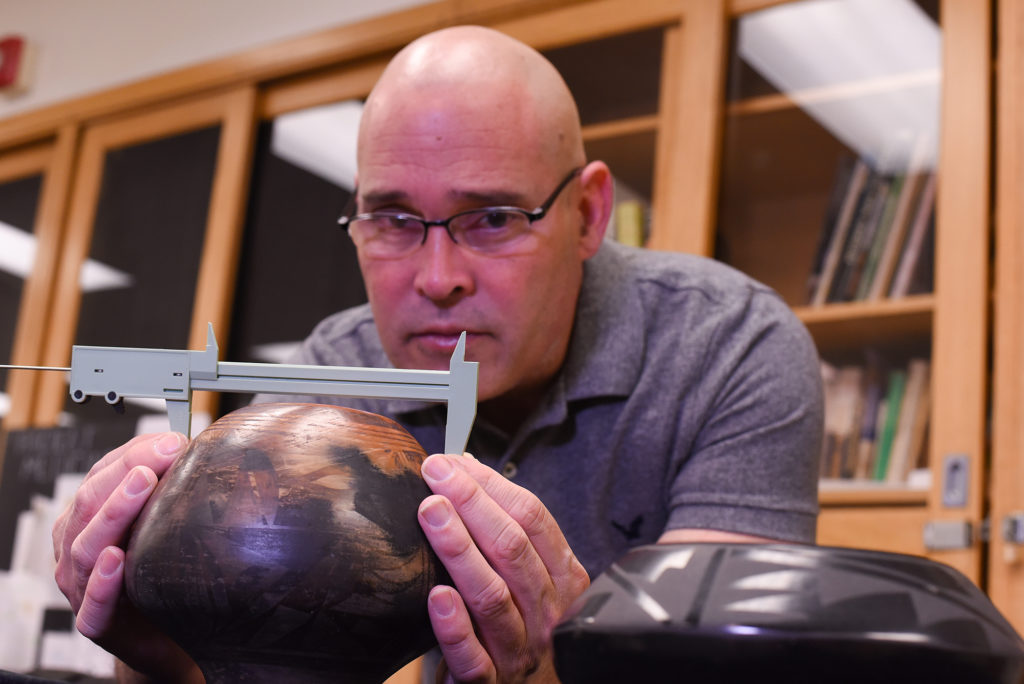
Las Vegas, N.M. – Anthropology students at New Mexico Highlands are learning first-hand about Indigenous Southwest pottery and baskets, thanks to the generosity of two sisters.
Margaret Hermann and Kathleen Walz have donated their mother’s collection of Southwest Native American pottery and baskets as well as Guatemalan Mayan huipiles, embroidered women’s blouses, to the Highlands anthropology program.
“I donated these items I inherited from my mother, Lenore Walz,’ collection because I felt like a caretaker and wanted them to have a permanent home,” Hermann said. “I also felt a responsibility to return them to their place of origin in the Southwest.
“I chose New Mexico Highlands University because Dr. Orit Tamir in anthropology had a vision of how to use the collection as a teaching tool for her students and the Las Vegas community. My mother wanted the pottery and basket pieces to be used and appreciated, rather than locked away in storage or in a museum,” Hermann said.
Hermann also donated more than 100 books to Highlands from her mother’s personal library on Native American history and anthropology.
Tamir, a cultural anthropology professor at Highlands, said the Highlands anthropology program uses the new collection to teach students how to track the “DNA,” or history, of a piece of pottery or basket.
“Most of the current collection is likely from the Santa Clara, Acoma, Hopi and San Ildefonso pueblos, and the baskets are Tohono O’odham and Akimel O’odham in origin,” Tamir said. “The Guatemalan textiles that will be donated soon open the door to study tribal textiles, the importance of design for village identity, Mayan women’s co-ops, and more.”
Tamir said the Highlands anthropology students are learning to distinguish among tribal styles in the pottery and baskets.
“They are also learning to track materials and the natural dyes the different tribes use, symbolism, and so on. It’s thrilling to have such a generous donation that allows our Highlands anthropology students to have hands-on learning experiences that one cannot gain from books or other sources” Tamir said.
Tamir said the donated collection was also used to teach students how to prepare it for exhibition in an art gallery. “Our Highlands anthropology students used the donated collection to contribute to a Native American art exhibit in the university’s Ray Drew Gallery in Donnelly Library in October 2018.”
Margaret Hermann said that “Watching the students discuss the artifact that they studied at the Ray Drew Gallery reception gave me pure joy, and also confirmation that our mother’s dream was fulfilled.”
Tamir said Victor Ramirez, now an anthropology graduate student, did an excellent job in 2018 of tracking the provenance of one piece of pottery, discovering that it was misidentified. Ramirez, 50, a native of Las Vegas, New Mexico, was an undergraduate in anthropology and sociology at the time.
“Victor’s excellent research uncovered significant information about the pottery,” Tamir said.
“When I first started looking at the pottery, I was told it was probably from the Santa Clara Pueblo because it’s black like traditional Santa Clara pottery,” Ramirez said. “However, up0n further examination, I noticed some different colors. Then, when I turned the pottery over, there was a design signature on the bottom.”
Ramirez said his research on the “frog woman” signature led him to determine it was created by Joy Navasie, a Hopi woman.
“Joy Navasie, who was born in the late 1800s, is one of the most famous Hopi-Tewa potters,” Ramirez said.
Ramirez said his research on the pottery inspired him to attend graduate school at Highlands. “With my undergraduate anthropology concentration in American Indian studies, the discovery of this pot’s origin convinced me to learn more about Southwest studies and anthropology. Dr. Tamir encouraged me throughout my studies and helped me believe in my academic potential.”.
